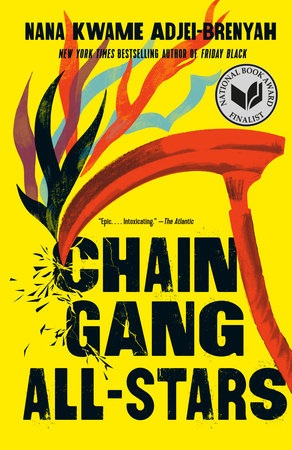Chain Gang All Stars: A Read with Jenna Pick Reader’s Guide
By Nana Kwame Adjei-Brenyah


1. Chain-Gang All-Stars is a work of speculative fiction that immerses readers in the United States of the near future, a technologically advanced society that is still troubled and defined by the laws, institutions, and social issues that we see today. Reflect on this setting. Why do you think Adjei-Brenyah chose to set the story against this backdrop?
2. Who are the Chain-Gang All-Stars and what is the CAPE program? How did the characters end up in this program and what made them join?
3. When we first meet Loretta Thurwar in the prologue, she is a new Link going up against Melancholia Bishop, a renowned fighter approaching High Freed status. When the novel continues, three years have passed and Thurwar is now in Bishop’s position as a Grand Colossal. What was the significance of her first fight, and how has her character changed since then? What keeps her fighting?
4. Chapter by chapter, Chain-Gang All-Stars brings readers into the stories of different stakeholders in the CAPE program, from Links and executives to fans and family members. Whose perspective were you most curious about and why? How did the multiple points of view reveal the many facets of the conflicts that are central to the story?
5. The lives of hard-action-sports fans are revealed through the point of view of Wil and Emily, a couple that watch the BattleGrounds and reality series LinkLyfe together. A reluctant fan, Emily’s interest in hard-action-sports teeters between horror and fascination. Why do audiences watch the matches, and how do they cope with the realization that they are complicit in these acts of violence? How is the reader also implicated in this?
6. On page 36, Thurwar explains that “The culture of Chain-Gang was death.” Describe the dynamic between the Links on the Angola-Hammond chain as well as the other chains in the circuit. How do the culture of death and the constant feelings of distrust and fear impact the chains? What do Thurwar and Staxxx attempt in order to gain trust and build comradery within Angola-Hammond?
7. Who is Tracy Lasser and what is her connection to the Angola-Hammond chain? How does her act of protest on live TV echo the antiracist movements in media, particularly sports media, that we’ve seen in recent years?
8. In the novel, Hendrix Young is one of the few characters that gets to speak in the first person. Why do you think the author chose to reveal Hendrix’s story from his own perspective, and how did this choice impact your understanding of his character?
9. How do society’s scientific advancements exacerbate the violent conditions experienced by the prisoners, particularly in the novel’s experimental prisons?
10. The story of Simon J. Craft is told through a fragmented narrative style. How is this literary choice used to illuminate the impact of solitary confinement on the mind?
11. On page 192, Hendrix explains, “Everybody got a name: a story of truths and lies.” Where do the nicknames of the Links come from and how do they come to define each character? Why do you think that it was notable for Thurwar to use her own name rather than a moniker?
12. Chain-Gang All-Stars imagines a world of brand-sponsored, pay-per-view prison entertainment to bring attention to the role of capitalism in the carceral system today. Before reading this novel, were you aware of the prison-industrial complex, prison labor, or the role that corporations play in the carceral system? How does the novel’s dramatization of these stakes allow readers to reflect critically on the real-life implications of this system?
13. Through Mari’s narrative, readers are brought into the lives of families of incarcerated people and the activists working to abolish the carceral system, efforts that echo current calls to defund the police and abolish prisons. What do these chapters reveal about the work of community organizers and activists? Did you learn anything new about these movements? How does Mari’s experience of having an incarcerated father inform her acts of protest over the course of the novel?
14. How would you characterize the novel’s ending and the freedom that Thurwar and Staxxx reach at the end? Triumphant? Mournful? A little bit of both?
15. During the final BlackOut, Staxxx and Thurwar discuss what they will do with their lives when they are free, giving readers the sense that there is more work to be done. What do they decide to do and what do you imagine happening for the novel’s characters, as well as the CAPE program, after the ending?
16. Adjei-Brenyah’s novel combines fiction with social justice by incorporating footnotes that provide readers with real-life stories and statistics about the experiences of incarcerated people in America. In the acknowledgments, Adjei-Brenyah writes, “This book is possible because of so many thinkers, activists, writers, and advocates who helped grow my point of view and guide research that deepened my understanding of our carceral world and country.” How did these footnotes add to the realism of the novel? What did you learn and what stood out to you? Did your perspective on the criminal justice system change after reading this story?
Just for joining you’ll get personalized recommendations on your dashboard daily and features only for members.
Find Out More Join Now Sign In